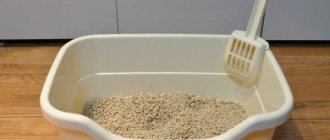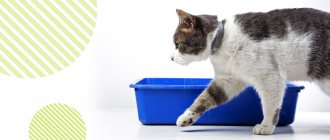If you want to accustom your cat to water, it is recommended to do this from a young age. Animals have developed a persistent dislike for taking water procedures; it is impossible to force a pet to bathe on its own. But there are a number of methods and recommendations for successful bathing. Little kittens can be taught not just to wash themselves in the water, but to fully swim in the bathtub.
Why is a cat afraid to swim?
Fear of water is an instinctive fear. Under natural conditions, wild cats will only get into water if their lives are in serious danger in order to survive. But there is an exception to the rule - tigers. They are considered good swimmers and can catch fish; they can easily withstand water procedures due to their fur; it repels water. Domestic cats generally do not like to bathe; some tolerate it peacefully, while others scratch, meow hysterically, and try to escape. There is an opinion that washing, especially with shampoo, can dry out the delicate skin of pets. Thus, real fear of pets leads to stress and resentment towards the owners.
Vivverina
Particularly interesting is the viverrina (felis viverrina), or, as it is also called, the Asian fish cat.
Her territory of residence is Hindustan, Sri Lanka, Indochina, Java, Bali, Sumatra. Vivverrina is a large animal, the average weight of males is 10-15 kg, females 6-7 kg. Surprisingly, this cat breed has webbed front paws. They prevent the cat from retracting its claws and help it catch fish. Representatives of this breed are not as graceful as other pussies, they do not like to climb trees, but they quite willingly wander through shallow water and, what is most interesting, choose deeper places! They are said to even dive 2 meters. So cats hunt underwater too. The vivverina's main diet consists of fish and crustaceans. It is worth saying that these creatures are not timid and are clearly not those who can answer the question “Why don’t cats like water?” There are known cases when a fishing cat scared a pack of dogs.
Many cats, especially kittens, are not averse to playing with water, and sometimes even ask to bathe them. It is worth noting that among the representatives of the cat family there are excellent swimmers. For example, jaguars, which not only swim, but also hunt fish and even turtles. And probably every person has seen a photo of a bathing tiger at least once in his life. They do this with great pleasure, but only in warm water.
Why wash?
Cat breeders with extensive experience clearly believe that pets need to be bathed in the following cases:
- in the presence of parasites, fleas, ticks in the coat;
- if serious contamination appears;
- as a means of prevention;
- during molting.
During coat changes, water treatments are required.
Cats shed periodically. When an animal licks its own fur, dirt and germs enter the body with saliva. During the molting period, the amount of fur increases and it is difficult for the pet to cope with its natural shedding. Thus, the digestive system of the pet is the first to suffer. To avoid this problem, it is recommended to combine the molting period with bathing the cat.
Tips and tricks
Below are recommendations that are suitable for bathing both a small kitten and an adult animal:
Do not trim nails immediately before bathing. Do this the day before or at least a few hours before. Many pets become a little irritable due to nail trimming
Nail trimming can be a new and scary experience especially for a baby, made worse by subsequent bathing.
Playing soothing music in the background will distract your pet from waiting for a bath. Music will help make the process more positive.
Bathe your pet in appropriate clothing: a short top that exposes the arms and belly is not suitable.
Wear a fairly thick shirt with long sleeves.
It's a good idea to close the bathroom door to prevent your furry from escaping.
Bathe your cat when she is calm. This is a very important point. Don't bathe her a minute after she's been playing, for half an hour after something has made her angry, or after she's become agitated by something in the room. Avoid bathing her just before a regular meal because the cat will probably be anxious and want to eat instead of bathe. It is better to choose a time when your pet is usually calm, resting, or simply relaxed. You can also schedule a play session that will tire your cat out, then wait half an hour for her to rest before bathing.
Be calm, as your excitement and tension will be transferred to the animal.
After bathing, be sure to reward your pet with treats and affection.
If you have multiple cats, it is possible that other cats will not recognize your washed pet and will hiss at it because you have washed away its identifying scent. Wash all your cats if possible. Either way, it will take a few days for the smell to return.
British kitten These little tricks will help make the process of bathing a kitten easier and then water procedures will be stress-free for him and for you:
- Make bathing fun for your kitten. If he is taking water treatments for the first time, then take his favorite toys and place them in the container where you plan to bathe the baby. Give your kitten a bath with joy so that he doesn’t think it’s a scary process or the container a terrible place. You can even play with him in the sink or basin without bathing him first to help him become comfortable in that environment. During bath time, you can also throw a few of his favorite toys or bath toys into the container. Allow your kitten to play with bath toys in a dry environment so that they don't make him afraid during bath time.
- If kitten shampoo isn't in your budget because it's expensive, Johnson's Baby Shampoo is a good option.
Rules for accepting water procedures
- If possible, you should accustom your kitten to water from a young age, bathing it once a month. Thus, in adulthood it is easier to achieve humility during the procedure.
- Cats have a higher body temperature than humans, for this reason it is imperative to strictly observe a comfortable temperature regime of 38-39 degrees.
- If the owner is lucky and the animal likes bathing, then by filling the bath with water you can give it time to swim and play with its favorite toys.
- In order for water procedures to become a habit, it is recommended to regularly and consistently follow all the rules and recommendations for training.
- After washing, you should not let the kitten go outside for 24 hours to avoid drafts.
- It is recommended to use special bathing products; there are liquid and dry shampoos.
- Make sure that the cat does not lick the fur until all the foam is washed off from the fur.
- You need to prepare several towels.
- You should not make loud noises, scream, or cause pain to your pet, otherwise stress cannot be avoided.
- The shampoo should not get into the eyes and ears, because it causes burning and irritation, which will discourage the pet from bathing for a long time.
For hygiene procedures, only specialized cleaning products are used.
For swimming you will need the following items:
- 2 containers with water;
- thermometer for measuring water temperature;
- rags;
- several towels;
- toys;
- special shampoos - liquid or dry;
- air conditioning (if necessary);
- comb-brush;
- sponge or small ladle;
- gloves for hands;
- robe or overalls.
What kind of water is best to give to a cat?
Tap water is the simplest and most harmless option. But it must be cleaned before being consumed. Many owners of aqua filters forget that the device needs to be constantly changed.
Filters wear out and stop doing their job. To clean the liquid from harmful substances, you can leave it in a tightly closed container for 6-8 hours. Running water contains a lot of oxygen; it attracts pets more than bottled or boiled water. This is why many cats love to climb into aquariums: they are always equipped with devices that saturate the water with oxygen.
Drinking fountains are an expensive pleasure, but this device is the most convenient and better purifies the liquid from harmful impurities. The liquid in such devices constantly circulates, enriched with oxygen and cleansed of harmful impurities. Some drinkers have a dome with a hole at the top.
It will be convenient for your pet to lick the dripping liquid. Veterinarians say that using a drinking fountain can quickly teach a cat to drink water.
Many owners, trying to please their pet, aggravate its condition. Boiling rids the liquid of parasites and the smell of chlorine. But when it evaporates, the concentration of salts increases. The resulting sediment mixes with the water and makes it “heavy.” Such drinking will not benefit the animal.
If you are concerned about the health of your family and pets, it is easier to buy bottled water. It's more expensive than pouring it from the tap. But bottled water reaches customers completely purified from harmful substances and parasites.
By looking at reviews, you can be convinced of the quality of a product of a particular brand. You cannot always be sure that the filters are working properly; they need to be constantly changed. Buying bottled water can be even more cost-effective than constantly changing purification devices.
How to teach bathing?
To teach a kitten to take water procedures, take 2 containers, one is completely filled with water, the other 5 centimeters. The temperature should be comfortable for the animal, 38-39 degrees. It is recommended to wear latex or rubber gloves and additional clothing in case the cat scratches. Place cloths or cloths on the bathroom floor to prevent slipping when water splashes. If the kitten starts to get nervous, you should calm it down, pick it up and stroke it. Carefully place the cat in a bowl with less water and slowly water the pet, starting from the back and lastly moving to the neck; there is no need to wash the ears and face.
To calm your cat, you can put your favorite toys in the bathtub. Afterwards, if necessary, apply a special shampoo and comb the coat with a comb. Then you need to thoroughly rinse the foam from the coat. If the kitten breaks out, it is recommended to hold it gently by the paws or withers, without screaming, rough movements and without using force. At the end of bathing, it is recommended to blot the pet with a soft terry towel and hold it in your hands for 10-15 minutes. The bathing procedure should be repeated once a month or when it is heavily soiled, because water can wash away the protective fat layer.
You should not tie your pet during the washing period. During panic attacks, a cat can harm itself with a collar or leash.
When holding an animal in the bathtub, use a firm grip. It is correct to grab the cat by the fold on the withers and avoid areas near the belly. So, the pet is able to instinctively attack with its hind legs. If he is overcome by panic and fear, it is recommended to wrap the kitten in a towel and leave the bathroom. If there is foam on the fur, remove it with a damp cloth and comb the animal.
Dry shampoo is the way out
So, the owner decided that bathing the cat is an objective necessity, but the animal does not let itself be handled, bites, scratches and protests against water procedures in every possible way. What to do?
The way out is to use dry shampoo. Even though the effect of such a procedure is not comparable to the cleanliness after washing, treating the fur with this product gives cats less discomfort than bathing.
The powder from the bottle is applied to the animal’s fur coat directly with your hands, making massaging movements with your fingers. After this, so that the product is distributed evenly, the pet is combed. There is no need to wash off the powder with water.
It is important to take precautions when working with dry shampoo. Firstly, the procedure should be carried out in a room where the floors can be washed (it is almost impossible to remove spilled cleaning powder from the carpet without damaging the latter). Secondly, use the product no more than once every six months
Otherwise, the animal will develop an allergic reaction to the shampoo. This leads to a logical disappointing conclusion: dry cleaning products are not a panacea, and sooner or later the cat will have to be washed in the traditional way
Secondly, use the product no more than once every six months. Otherwise, the animal will develop an allergic reaction to the shampoo. This leads to a logical disappointing conclusion: dry cleaning products are not a panacea, and sooner or later the cat will have to be washed in the traditional way.
How to teach an adult animal to take a bath?
Sometimes an adult animal has to be taught to wash, for example, if a person takes in a stray cat. This is a difficult process, since the new ward has already formed a character, and water procedures will be new to him. In this case, you need to try to switch your pet’s attention from the water to something interesting. You need to gradually teach your animal to bathe without stress for him and the owner:
- If the cat does not want to be in the bathroom, he should be taught to go there willingly with the help of treats and toys. The same is done when an animal does not like the sound of water flowing from the tap.
- You also need to train your pet to be calm in the bathing container using toys and games. To begin with, it is better not to pour water into it or add it to a level of 1–2 cm.
- To keep the cat stable and comfortable, place a rubber mat or towel on the bottom of the bathtub or basin.
- It is important to ensure that the pet can freely leave the bathing container at will. This will make him more confident and not feel trapped.
- It is necessary to observe what objects or actions accompanying bathing cause aversion in the animal. They need to be excluded or the pet must be forced to gradually get used to them.
- The pet should be praised, petted and encouraged for showing interest in playing in the water or staying in the bath.
- An important factor in creating favorable conditions for swimming is good lighting. Lack of light can cause further stress.
Interesting facts about waterfowl cats
The Turkish Van is considered a special waterfowl breed. Their front paws are equipped with special membranes that allow them to quickly row in the water, and their fur repels dirt and moisture well and practically does not get wet.
The Turkish Van is an excellent swimmer
The Turkish Van is an unsurpassed hunter; he chases not only rodents, his attention is attracted by various insects: beetles, butterflies, grasshoppers. If you need a fishing companion, he will be only too happy
He will happily spend time in nature, chasing a school of small fish in the shallows.
However, the fishing cat is rightfully considered the record holder for fishing. The wild swimming cat lives in southeast Asia (Indochina, Ceylon). Another name is speckled. Its weight can reach 15 kg. The cat has powerful jaws. It is unlikely that it would occur to anyone to tame an aggressive animal.
The front paws of the fishing cat, like those of the Turkish Van, are equipped with membranes. They prevent the claw plates from retracting and help in diving and fishing. With such equipment, it is not scary to swim long distances in search of prey. Swimming is his strong point, so the hunter lives near swamps, small lakes, and slow rivers flowing through tropical forests.
Cat fisherman with prey
How to bathe a kitten so that it is not afraid?
To accustom your pet to bathing, it is better to start procedures from an early age. At 2 months, the baby can be bathed for the first time (without using shampoo), but veterinarians advise postponing this manipulation until 4 months. Bathing a very tiny baby will wash away the postpartum lubricant that protects it from infections. It can also interrupt the kitten’s natural scent, and the cat will refuse it.
At 3–4 months, as a rule, the baby is separated from his mother, so he can more easily endure the stress of immersion in water. Not every animal can get used to being washed, but the owner must be patient and follow the basic recommendations:
- Introduce the kitten to the basin - it should not cause him fear. The baby should be placed in the container before pouring water into it. Let your pet sit in it, smell it, and get used to it.
- The animal is taken out of the basin, water is poured at a temperature of 38–40°C to a depth of 5–7 cm. The pet is placed in water, held tightly by hand and talked to in a calm, even voice.
- The kitten's head is quickly wetted, making sure that the liquid does not get into the ears and nose. The shampoo is thoroughly washed off, since its residue on the fur can harm the animal. The procedure time should be kept to a minimum. During the process, the pet is petted to calm it down.










